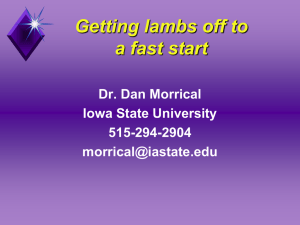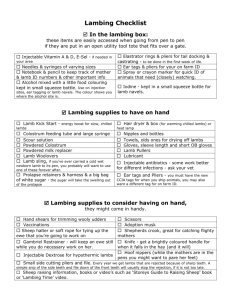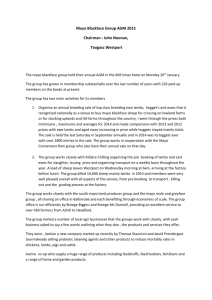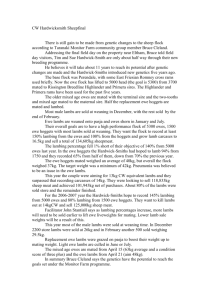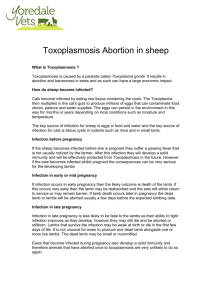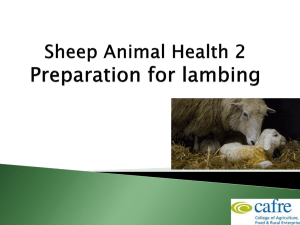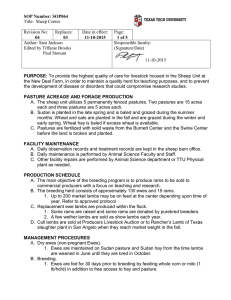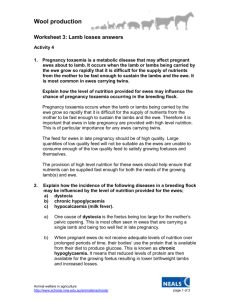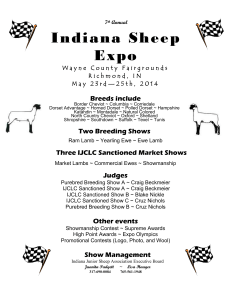Sheep Animal Health Week 3 Vet session 12.9MB
advertisement
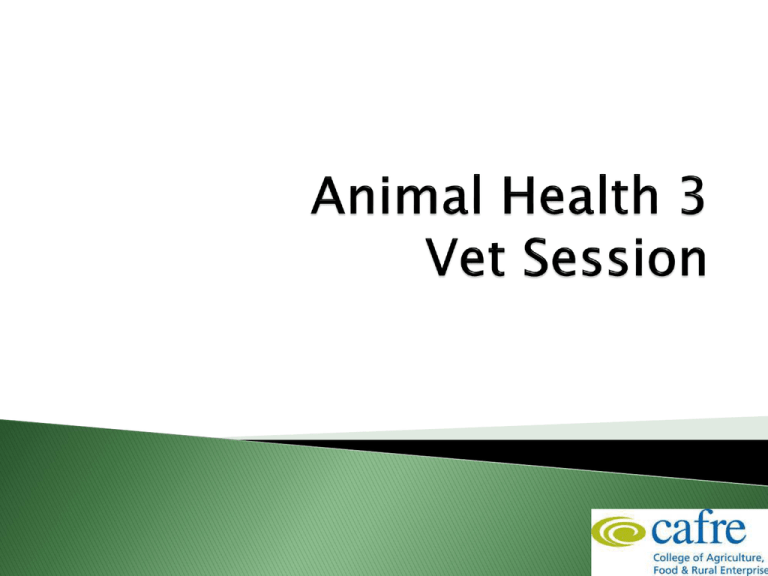
Enzootic and toxoplasmosis abortions Mineral deficiencies ◦ Cobalt ◦ Copper Coccidiosis Footrot and CODD Rumen fluke Diseases/Conditions at lambing Lambing management Treatment of hypothermic lambs Q & A session Enzootic Toxoplasma Occurs during late pregnancy ◦ Stillborns or weak lambs, die shortly after birth Ewes becomes infected at lambing, aborts at next lambing ◦ Rarely abort more than once Once infected the ewe become a carrier ◦ Sheds bacteria at subsequent lambings so constant source of infection to other sheep ◦ Ewe lambs infected at birth, will abort at their first lambing Disease maintained in flock Isolate aborted ewes Treat remaining with long-acting oxytetracycline injection Vaccination Ewes usually only require single dose for lifetime protection ◦ From 5 months old ◦ In the 4 month period prior to mating ◦ At least 4 weeks prior to tupping Can cause abortion at any stage of pregnancy after consuming infected feed or water Early pregnancy, infection of the womb & embryo death Mid-pregnancy (most common), they abort 45 days later (late pregnancy). Mummification is an important sign in Toxoplasma abortion Infection in non-pregnant sheep results in immunity Lambing Tupping Not pregnant • No effect Early pregnancy • Resorption • Barren ewe Mid pregnancy • Mummified lambs • Abortion Late pregnancy • Abortion • Stillbirth • Weak lambs Upmost care should be taken with feed to prevent contamination Vaccination ◦ ◦ ◦ ◦ In the 4 month period prior to mating At least 4 weeks prior to tupping 2 year booster interval Most ewes only receive a single injection Vaccination has a10 days shelf life Symptoms: Empty and pot bellied. If severely affected, animals are pale and anaemic. Cobalt is used for the manufacture of vitamin B12, which is used in the liver for energy production. Growing animals have a higher requirement for this vitamin. Treatment: Supplementation using oral drench or injection. Symptoms: Swayback in young lambs. Affected lambs are bright but uncoordinated with weakness of the hind limbs, which results in swaying or stumbling. Treatment: Copper supplementation by Oral drenching with copper salts. Free access minerals. Copper injections or capsules Symptoms: Animals become increasingly weak. Wandering aimlessly or head-pressing. Jaundice develops and breathing becomes shallow and rapid. Most animals die following a short period of recumbancy. Prevention : Avoid feeding diets high in copper Treatment response is poor in animals showing clinical signs. Use of Copper antagonists such as molybdenum or sulphur. Symptoms: Acute onset diarrhoea, dullness, dehydration and weight loss. Cause: Sheep specific protozoan parasites. Following the ingestion the parasite invades and multiplies in the cells of the lining of the intestine. After a period of 2-3 weeks the oocysts are shed in the faeces further contaminating the environment. Treatment: Medicated creep feed. Diclazuril administered orally to lambs. Symptoms: Swelling and moistening of the interdigital skin. Foul smelling discharge. Separation of the horn from the foot. In advanced cases animals are extremely lame, and may carry the affected leg. When both forelimbs are affected, animals may walk on their knees. Treatment: Antibiotic spray on clean dry hoof combined with a long acting antibiotic Do not foot trim Vaccination Persistently affected sheep should be culled. Symptoms: Starts as small ulcers at the coronary band and moves down the claw, undermining the horn Hair loss above the coronary band Horn may become detached Treatment: Do not trim Consult your vet as antibiotic treatments are not always effective Culling Good biosecurity vital Symptoms: Tear staining from the corner of the eyes. Cornea becomes cloudy. Discharge becomes thicker and pus-like. When both eyes are severely affected the sheep will become temporarily blind. Cause: Bacteria – chlamydia psittaci Close contact of sheep when trough feeding enables rapid spread of infection. Treatment: Is tedious and involves the application of an ointment. Intramuscular injection of long acting oxytetracycline. Contagious tumour of the lungs, often not diagnosed Spread of disease is facilitated by close confinement during winter housing period Clinical disease – apparent in two to four year old sheep Signs Loss of body condition Panting Nasal discharge Diagnosis – no blood test, only detected at post mortem Treatment – None available, slaughter infected sheep Good biosecurity important Rumen flukes occur worldwide and in recent years, the prevalence of rumen flukes in Ireland has increased. It is likely that small numbers of this parasite cause little or no damage The significance of this parasite seems to be directly related to the number of immature rumen flukes present in the small intestine. A small number of reports of this parasite causing serious disease and production loss on farms have been seen where heavy burdens of larval flukes were taken in by grazing cattle or sheep over a short period of time. SYMPTOMS - dullness - dehydration - rapid weight loss - severe watery scour, which may contain traces of blood - low blood protein concentrations - swelling under the jaw, known as bottle-jaw CONTROL -Biosecurity -Reduce exposure -Treatment – most drugs that kill liver fluke do not kill rumen fluke DO NOT TREAT RUMEN FLUKE UNLESS CLINICAL SIGNS ARE PRESENT Prolapse of the vagina / uterus Mastitis Calcium deficiency Magnesium deficiency Twin lamb disease Listeriosis Retained cleaning Causes and predisposing factors Treatment Prevention Cause: Bacterial infection - Staph aureus, E coli. and Pasteurella. Infection usually occurs after lambing. Clinical mastitis - udder becomes swollen, warm, sometimes painful to the touch. Ewes become feverish, off their feed and become depressed. They may refuse to allow their lambs to suck. Sub-clinical mastitis – ewes usually appear quite healthy but milk supply is reduced and they develop lumps in their udders. Ewes need to be watched carefully to prevent the potential damage. Control: Good management. Bedding should be clean and dry and animals should not be overcrowded. Treatment: Antibiotics – consult with vet A metabolic disorder in last 4-6 weeks of pregnancy Low levels of calcium in the blood, demand greater than diet provides Signs ◦ Ewes are unsteady, lie down, gradually become comatose, death ◦ Some sheep will have a discharge from their nose, can be mistaken for pneumonia The condition often co-exists with twin lamb disease Prevention: Feed Calcium in late pregnancy (5-10g Ca / day) Minimise stress at point of lambing Remove older thinner ewes/broken mouths which are more susceptible Treatment : An injection under the skin of a calcium solution is usually successful. ‘Grass staggers’; ‘grass tetany’ Low blood magnesium – most common on fast growing lush spring grass (low in magnesium) – triggered by poor weather Acute fits/staggers - rapid death Prevention - Provide a daily intake of magnesium Use Mg licks/meals in risk situations such when moving on to lush swards/poor weather Feeding concentrate post lambing at grass (Limited period) Treatment: Twin lamb drench (propylene glycol) and offer good quality concentrate and forage. If ewe fails to respond, she requires intravenous glucose (+/- calcium) Symptoms: Bacterial infection that is limited to one side of the brain hence one-sided appearance of nerve paralysis. Initially, affected animals do not eat/come to the feed trough, are depressed, disorientated and may propel themselves into corners, into fences, or under gates and feed troughs etc. CAUSE: Poor quality silage that has a poor fermenation Most cases occur 14-21 days after feeding the contaminated silage. TREATMENT: If recognised early, treatment with high doses of antibiotics can be effective. Ensuring that only good quality silage is fed to sheep. Normally born head first with the front feet tucked up under the chin Dystocia can occur due to large and or/ malpresentation Normally takes about 1.5 hours EDA 3 Ewes that don’t pass cleaning - ◦ Cleaning should be past shortly after the lambs are born. ◦ Lambs suckling encourages the process ◦ Stimulated by hormone oxytocin ◦ If cleaning not past treat with long acting antibiotic ◦ On no account forcibly remove the afterbirth Colostrum – ensure lambs get an adequate intake Approximately one million neonatal lamb deaths are attributed to hypothermia each year in Britain. Lambs most commonly die from hypothermia during the first 72 hours of life. Cause: High rate of heat loss from exposure. Combination of heat loss and starvation. Prevention: Ensuring adequate nutrition of the pregnant ewe. Avoiding birth stress/dystocia. Ensuring that newborn lambs feed. Provision of shelter. Depends on temperature of lambs and blood sugar levels Bring indoors and towel dry lambs If 39oC do not warm, hypothermia not the problem If 37- 39oC moderate hypothermia, normally do not require warming. Feed colostrum by stomach tube and return to mother If below 39oC severe hypothermia. Lamb will not suck and temp will continue to drop unless warmed. If less than 5 hrs old place in warming box until temp reaches 37 then stomach tube with colostrum If older than 5 hrs blood sugar levels likely to be low. Never warm before feeding. Stomach tube with colostrum if lamb can hold its head up if not give injection of glucose solution A warming box is an essential piece of kit. Lambs temperature should be checked every 20 minutes. Never put a wet lamb under a heat lamp. Water will boil on the skin Interaperitoneal glucose injection. Needle is inserted below and to the side of the navel and directed towards the tail head Symptoms: Wet mouth, depression, salivation. Cause: Reduced or delayed colostrum intake, which enables rapid multiplication in the intestinal tract of E Coli. Treatment: In advanced cases is often poor and not justified. Preventative treatment of oral antibiotics to all lambs within 15 minutes of birth is effective. Symptoms: Common disorder, which is characterised by turning in of one or both lower eyelids. Seen in most breeds of sheep and is probably inherited. Painful and affected eyes appear half closed and watery. Unless treated the cornea becomes cloudy and ulcerated, leading to permanent blindness. Treatment: Minor cases respond to manual eversion of the lower eyelid. More severely affected eyes are usually treated by injection of about 1ml of penicillin under the eyelid. Symptoms: Redness and slight swelling of the skin. Blisters form, which develop into thick scabs After about 3 weeks scabs are shed leaving a layer of raw skin which heals quickly Cause: pox virus which can remain infective in the Orf is highly contagious environment for many months in dried scabs Treatment: Oxytetracycline aerosol sprays can be applied to control the secondary infection. Severely affected animals may benefit from antibiotic injections. Flock Health plans Should be produced in conjunction with your own vet Documents routine procedures, treatments and vaccinations Quality assurance scheme requirement Prevention is better than cure Questions Any questions?

